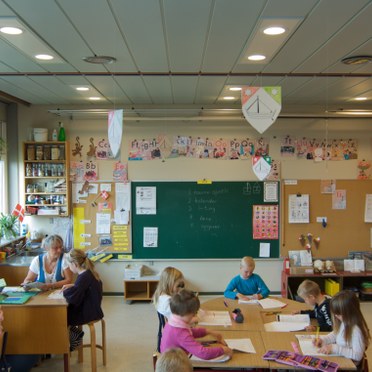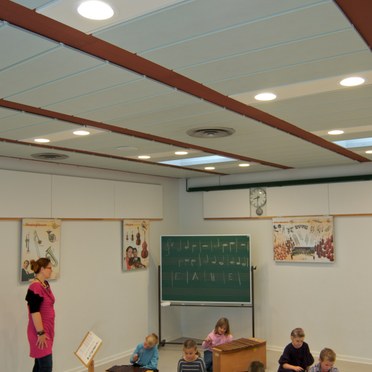Hanstholm School, Denmark
- Lamp efficacy
Lamp efficacy
Ensuring the lamp efficiently converts electricity into light (lm/W).
- Ballast classification
Ballast classification
Controlling the electricity supply to the lamp (Energy Efficiency Index).
- Luminaire distribution
Luminaire distribution
Controlling light emission using optics which bend and shape the light to the correct location.
- System efficacy
System efficacy
Combining optical and thermal control within the luminaire (luminaire lm/W).
- Presence/absence detection
Presence/absence detection
Presence: Lights automatically turn on/off with movement. Absence: Lights automatically turn off and must be manually switched on.
- Daylight detection
Daylight detection
Artificial lighting which responds to the natural light conditions.
- Constant illuminance
Constant illuminance
A function designed to produce correct light levels for the duration of the maintenance period.
- Task-scene setting
Task-scene setting
Allowing the user to set scenes and adapt the lighting to different tasks.
- Timed off
Timed off
Automatic cut-off can be installed to turn all lights off during unoccupied hours.
- Task lighting
Task lighting
Lighting task areas with the correct amount of light.
- Zoning of lighting
Zoning of lighting
Lighting is zoned according to area use.
- Maintenance schedule
Maintenance schedule
Maintenance must be performed in response to product age, performance and environment.
- Waste light
Waste light
Eliminating waste light which does not hit the intended target.
- Reflectance
Reflectance
Taking advantage of light which is reflected from the surface within the space.
- Visible smart metering
Visible smart metering
Results of actions can be quickly seen as increased or decreased energy use to encourage responsible energy consumption.
Thorn slashes energy costs for Thisted Kommune with 70% saving
With 5 million Danish kroner (£0.6m; €0.7m) dedicated to energy saving solutions the municipality of Thisted Kommune is serious about sustainability. And, Thorn is doing all it can to help.
Pictured here is part of Hanstholm School in northern Denmark where Base LED 650 downlights have cut energy requirements by about 70%.
The frames of ageing fluorescent fittings were easily conveted to accept a back plate complete with two LED downlights. Replacing twin 36W tubes in each light point, the Base LEDs have substantially reduced electrical consumption, from 90 to 24 circuit watts per unit, whilst still maintaining the same lighting levels.
Lasting 50,000 hours, the downlights also require less frequent maintenance. In addition the benefits of a warmer colour with better colour rendering can be brought to the classroom. Little wonder that John Nicolajsen, Hanstholm's headmaster, is so pleased.
"Both students and teachers have noticed changes, although it is only now, when darkness is pressing that we really enjoy more light. And I am convinced that the light is important for both learning and well-being at school." he says.



